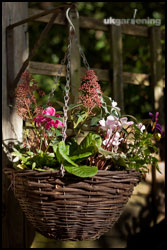 Planting up a winter hanging basket or container.
Planting up a winter hanging basket or container.
Once the summer hanging baskets have come down and the tender plants are tucked up for the winter, fences and patios can look a bit drab and boring. Now is a great time to fill those empty brackets and containers with some baskets full of colourful and hardy plants.
Whilst the summer baskets and containers are mostly about the lush green foliage and vibrant colours of the flowers, because of the coldness of winter, very few plants will grow and fewer will flower. Even plants such as winter flowering pansies will flower in the late autumn, lose their flowers when the temperature drops to a few degrees below freezing, before flowering again in the spring.
In the absence of colourful flowers, we have to change tack and go for leaf colour, shape and texture as well as bright shiny berries (such as a dwarf holly or Gaultheria procumbens Checkerberry/wintergreen) or colourful flower buds (such as the skimmia I've used in my baskets below).
Small bulbs such as muscari (grape hyacinth), miniature tulips and daffodil (e.g. 'Tête-à-tête') they won't put on growth until the early spring before flowering in March/April
Use dwarf/small, bright green conifers, winter flowering heather, a small hebe or skimmia japonica (which is what I've used here) as the central focal plant.
Where do I get my plants from?
I have quite a few baskets, pots and containers to fill, so I save a lot of the plants from one year to the next. When I'm emptying the baskets prior to planting them up with summer bedding, I pot up the cyclamen*, primulas*, conifers and hebes and take cuttings of the skimmia. I also buy a couple of trays of pansies and some cineraria maritima to fill in some spaces and create a bit more interest in the basket. I could grow both of these from seed, but the pansies are £4 for 20 plugs, which I don't think is too expensive and it saves having to keep them slug free and from getting 'leggy' during the summer.
If you are buying plants, choose evergreens or frost hardy plants that have interesting leaf shape, texture or colour, because the flowers won't usually last through a cold spell.
* Before planting up into your basket, check the roots of any plants that look a bit weak, I've found vine weevil grubs a few times with cyclamen and primulas.
Steps to plant up a winter basket or container:
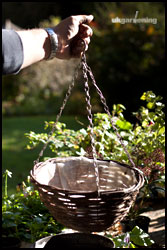 Once you've emptied your basket of the summer plants or found/bought a new basket. Hold up the basket by the hanging hook, to work out which way is going to be the front of the basket, face this towards you, as you are going to plant with the best plants to the front. If the supporting chains are a bit on the long side try to shorten them as much as possible, longer chains will cause the basket to blow around more in the winter weather.
Once you've emptied your basket of the summer plants or found/bought a new basket. Hold up the basket by the hanging hook, to work out which way is going to be the front of the basket, face this towards you, as you are going to plant with the best plants to the front. If the supporting chains are a bit on the long side try to shorten them as much as possible, longer chains will cause the basket to blow around more in the winter weather.
Sit the basket on a large plant pot to stop it rocking whilst you are trying to plant it up. Make sure the chain falls outside of the basket and clip the hook to the side of the basket to stop the chain getting tangled up.
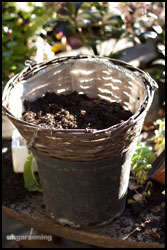 The basket that I'm using is plastic lined. If you've got something similar, poke a skewer through the plastic, to create a couple of drainage holes in the bottom of the basket, to allow excess water to run out.
The basket that I'm using is plastic lined. If you've got something similar, poke a skewer through the plastic, to create a couple of drainage holes in the bottom of the basket, to allow excess water to run out.
Don't put a saucer in the bottom of the basket as you might for a summer basket, the idea of the saucer is to try and reduce moisture loss, with a winter basket you don't want the plants sitting in water. More often than not it's the cold and wet that kills plants, rather than just low temperatures.
Half fill the basket with compost, I use my own, but if you don't have a compost heap, a general multi-purpose compost will be perfect. Don't worry about using water retaining gel/crystals as you perhaps would with a summer basket, again you don't really want to keep the moisture in. I also don't bother with slow release fertiliser, the plants won't grow much over the winter and there's sufficient nutrients in the compost to keep them happy until spring.
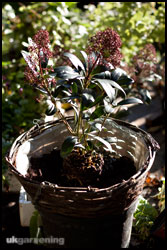 Start with the focal plant in the middle, turning it so the best side faces you (i.e. the front). I've got one of my skimmia japonica cuttings, that I took in the spring. It looks a bit scrawny I'll admit, but they do fill out quite quickly, I like the small tight flower buds that give the impression of pretty little pinky-red berries. A small acid green conifer will also work well as a main focal plant (see planter below), as will a small hebe.
Start with the focal plant in the middle, turning it so the best side faces you (i.e. the front). I've got one of my skimmia japonica cuttings, that I took in the spring. It looks a bit scrawny I'll admit, but they do fill out quite quickly, I like the small tight flower buds that give the impression of pretty little pinky-red berries. A small acid green conifer will also work well as a main focal plant (see planter below), as will a small hebe.
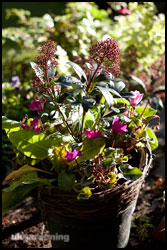 Working from the back to the front of the basket, add some of the taller and trailing plants at the back (furthest away from you), such as cineraria, thyme and with one or two variegated ivies and then equally space the rest of the smaller plants, in my case, cyclamen, primula/polyanthus around the rest of the basket, filling any gaps with plenty of pansies. You are aiming to create a very loose cone shape to the planting.
Working from the back to the front of the basket, add some of the taller and trailing plants at the back (furthest away from you), such as cineraria, thyme and with one or two variegated ivies and then equally space the rest of the smaller plants, in my case, cyclamen, primula/polyanthus around the rest of the basket, filling any gaps with plenty of pansies. You are aiming to create a very loose cone shape to the planting.
Pack lots of plants in, once the cold weather comes, you'll lose the flowers and some of the leaves (especially with cyclamen, if it gets really cold) and if the basket or container isn't densely planted it may look a bit sparse during the colder months of Jan and Feb.
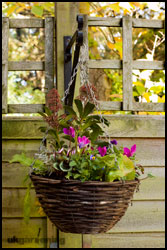 Carefully add compost to the basket, to top up the level, I tend to put one hand over the plant, whilst tipping a small amount of compost around it, gently firming the compost as I work my way around the basket.
Carefully add compost to the basket, to top up the level, I tend to put one hand over the plant, whilst tipping a small amount of compost around it, gently firming the compost as I work my way around the basket.
Once you're happy with the amount of planting and the compost if covering the roots of all the plants, hang the basket up and water well. It might seem a bit strange to water, especially if it's cold, but the watering will force the compost to fill any air pockets, ensuring that the roots are in contact with the soil. Hanging the basket up before watering will reduce the amount of weight you have to lift, as you won't have to lift the weight of the basket and water in one go. If you struggle with the weight of the watering can, just fill it a quarter full, or use empty milk cartons, filled with water. Once the water and plants have settled, you might have to top the baskets up with a little more compost.
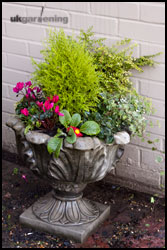 A planter filled in the same way as the baskets above, but using a small conifer as a focal plant with thyme and ivy at the back and cyclamens and polyanthus at the front of the planter.
A planter filled in the same way as the baskets above, but using a small conifer as a focal plant with thyme and ivy at the back and cyclamens and polyanthus at the front of the planter.
Other gardening how to pages:
- Growing plants from seed
- Create a hanging basket
- Laying a new lawn
- Making leaf mould
- Chitting and growing potatoes
- Care of Hippeastrum/Amaryllis after flowering
- Cleaning patios, paths and decking
- Removing large branches
- Creating a compost heap
- Moving a tree or large shrub
- Fencing and trellis
- Building a rockery
- Planting a winter basket
- Building a pond
- Make a large spirit level
